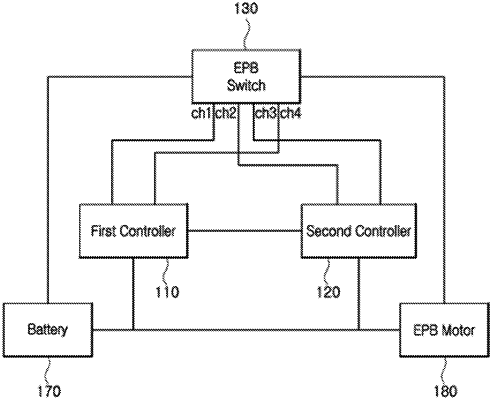| CPC B60T 8/885 (2013.01) [B60T 2270/402 (2013.01); B60T 2270/406 (2013.01); B60T 2270/415 (2013.01)] | 18 Claims |

|
1. An Electronic Parking Brake (EPB) control apparatus comprising:
a first EPB switch having a plurality of terminals;
a first controller connected to a first pair of the terminals of the first EPB switch, and configured to:
combine a first pair of signals received from the first pair of the terminals, respectively;
calculate a first signal value based on the combined first pair of signals; and
diagnose a state of the first EPB switch based on the first signal value; and
a second controller connected to a second pair of the terminals of the first EPB switch, and configured to:
combine a second pair of signals received from the second pair of the terminals, respectively;
calculate a second signal value based on the combined second pair of signals; and
diagnose the state of the first EPB switch based on the second signal value,
wherein the first controller is further configured to:
determine whether any one of the first EPB switch, the first controller and the second controller exhibits a failure based on the first signal value;
determine a location and cause of the failure; and
diagnose a final state of the first EPB switch based on the location and cause of the failure,
wherein the plurality of terminals of the first EPB switch includes first to fourth terminals,
wherein the first controller is connected to the first and fourth terminals and configured to transmit a first state request signal to the first terminal,
wherein the second controller is connected to the second and third terminals and configured to transmit a second state request signal to the second terminal, and transmit a third state request signal to the third terminal, the third state request signal being different from the second state request signal, and
wherein the first controller is further configured to transmit a fourth state request signal to the fourth terminal, the fourth state request signal being different from the first state request signal.
|